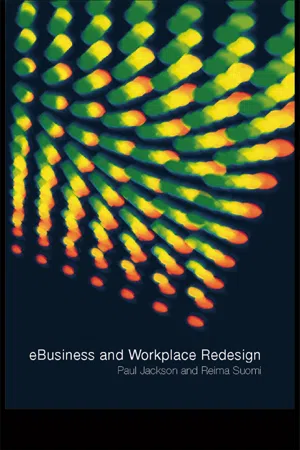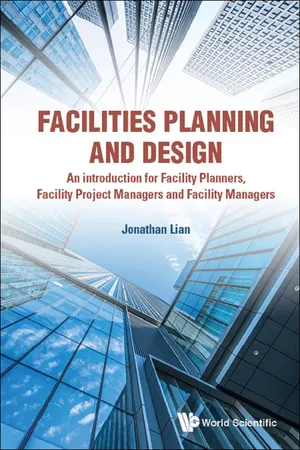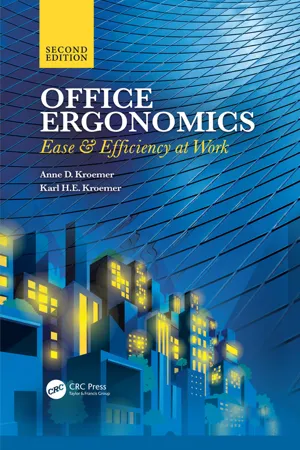Technology & Engineering
Workplace Design
Workplace design refers to the process of creating a physical environment that is conducive to productivity, collaboration, and employee well-being. It involves the strategic arrangement of furniture, equipment, and other elements to optimize workflow and support the needs of the workforce.
Written by Perlego with AI-assistance
Related key terms
Related key terms
1 of 4
Related key terms
1 of 3
3 Key excerpts on "Workplace Design"
- eBook - ePub
- Paul Jackson, Reima Suomi, Paul Jackson, Reima Suomi(Authors)
- 2003(Publication Date)
- Routledge(Publisher)
Part 2: Workplace architecture and design
In Part 2 we turn to the realm of architecture and facilities management and examine their importance to the physical aspects of work. Chapter 4 by Cristina Caramelo Gomes, Ghassan Aouad and Marcus Ormerod focuses on ‘sustainable workplace’ design in the context of eBusiness and new methods of work. They note that a workplace is a central concept for several entities: the worker and his/her family, the employing organisation, the customers of the organisation, and the society as a whole. All have different expectations towards working methods and places, with the task of optimising the whole a daunting one. The work design phase is made more complex by new information and communication technologies, given the way they increase available design possibilities. At the same time, the authors argue, expectations of work and workplace conditions have grown because of the increased awareness of better options for performing work. The authors note that as part of these developments, workers themselves also need to adapt and that the new workforce needs much more flexibility than workers previously.At the heart of the authors’ argument is the belief that changes in work organisation must be designed in ways that sustain both social and ecological resources. To do this we need to overcome established practices in the design and building of workplaces, and support the greater temporal and spatial flexibility demanded in new methods of work. Indeed, by providing for new forms of occupancy (such as non-territorial offices and teleworking), they argue that we can both achieve a higher quality of working life and improve our relationships with the wider community.The authors conclude by presenting a conceptual model to support the whole process of designing and managing a modern and flexible workplace. It therefore encapsulates their core argument that the new office should be a sustainable structure while also giving due consideration to environmental issues. - eBook - ePub
Facilities Planning and Design
An introduction for Facility Planners, Facility Project Managers and Facility Managers
- Jonathan Lian(Author)
- 2018(Publication Date)
- WSPC(Publisher)
ART 3Workplace Planning and DesignPassage contains an image
CHAPTER 9
Workplace Planning and Design
In this chapter, you will learn about the following: 1.Key trends that are driving change in organisations and the workplace 2.Changes in workspaces, meeting spaces, support spaces and technology 3.Essential #9 – Considerations that must be taken in the planning and design of offices 4.Challenges in implementing a new office concept 5.Coworking spacesEssential #9Understand the considerations in the planning and design of workplaces.The previous chapters considered planning and design at large scales (e.g. building scale and campus scale). This chapter considers planning and design at a smaller scale, specifically office spaces. This chapter also seeks to help the reader consider planning and design in the context of a particular type of facility — offices.Many people spend at least forty hours a week at their workplace. This accounts for a substantial portion of their time. Hence, it is important that their workplaces are well-planned and well-designed. Another reason is that the layout and design of the workplace can affect a worker’s productivity and job satisfaction.This chapter will focus on workers in an office setting as this is the situation that is most typical. The layout and design of an office is determined by the organisation whose employees occupy the office. The organisation’s activities also drive the layout and design of the office.9.1Key trends driving change in organisations and the workplace
According to the Whole Building Design Guide (WBDG) (2017) there are three key trends that are driving change in organisations and the nature of work:•Globalisation and increased competition. •The Information and Communications Technology (ICT) revolution. •The increasing pace of change resulting from increased competition and the technology revolution.Globalisation has brought out enhanced competition which has led to companies needing to become leaner. Organisations strive to be ‘lean’ in a drive to become more competitive, agile and focused on the customer. - eBook - ePub
Office Ergonomics
Ease and Efficiency at Work, Second Edition
- Anne D. Kroemer, Karl H.E. Kroemer(Authors)
- 2016(Publication Date)
- CRC Press(Publisher)
The first step is to analyze the needs of the people who will inhabit the office, including the tasks they will perform, the machinery and equipment they will use, and their preferences and work styles. Based on such analysis, the designer (ideally a team of ergonomists, engineers, or architects) should formulate specific statements of these functional requirements; they guide the actual design. The next step is to identify a range of design options so that practical solutions can be chosen; this reflects the need to compromise in the “real” world since the conceptual ideal is not always possible or practical. Then, these options are evaluated (see Tables 4.1 and 4.2) and final solutions are selected. Finally, the chosen design is implemented and put to use, with plenty of training and support provided for the employees. Note that these steps apply also, in principle, to remodeling or updating an existing office. Employees should be involved in all phases of the process so that their needs are truly met and they do not feel manipulated or ignored. I NDIVIDUALITY AND F LEXIBILITY A pervasive trend in office space design today is the consideration of individuality and personal direction, now especially feasible due to advances in technology. Current engineering know-how allows us to design almost any environment we wish. Yesterday’s technology tied us to one office, even to one spot inside that office, because we were bound by wired phones and computers, cabled machines, and stationary equipment; now, many of us can be flexible in location, work schedules, and habits. Note: You may skip the following section and go directly to the “Ergonomic Design Recommendations” section at the end of this chapter—or you can get detailed background information by reading the following text. A Short History of Office Design Over the course of the past century, not only has our relationship with work evolved, but the spaces we occupy for work have changed as well
Index pages curate the most relevant extracts from our library of academic textbooks. They’ve been created using an in-house natural language model (NLM), each adding context and meaning to key research topics.
Explore more topic indexes
Explore more topic indexes
1 of 6
Explore more topic indexes
1 of 4


